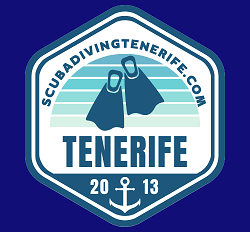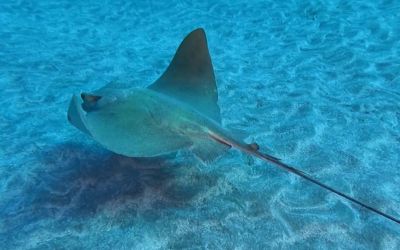
Did you know that there are differences between stingrays and manta rays? And most importantly, where can you have the opportunity to see them both in Tenerife?
We explore the unique characteristics of these marine creatures and guide you to the best places to dive and enjoy the experience of diving with stingrays and manta rays in Tenerife.
Where to see stingrays and manta rays in Tenerife?
Stingrays and manta rays move around the south coast of Tenerife in many places, although these are the dives where you are most likely to see them:

Diving in Abades
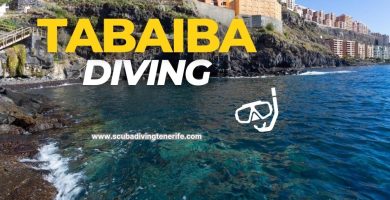
Diving in Tabaiba

Diving in Montaña Amarilla (Yellow Mountain)

Diving in Bufadero (Palm-Mar)
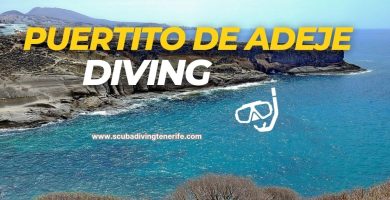
Diving in Puertito de Adeje (Armeñime)

Diving in the Cueva de los Camarones or Cueva de Juanito (Juanito’s Cave)
What are the differences between a stingray and a manta ray?
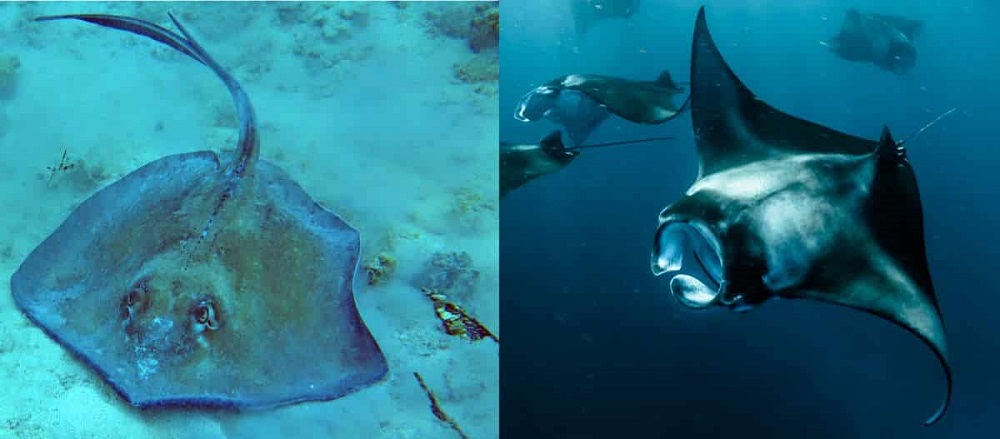
Stingrays (Rajidae) and manta rays (Mobula birostris) are two types of cartilaginous fish belonging to the order Myliobatiformes.
Although they share many characteristics, there are some notable differences between them.
- The main difference between the two is their size, as manta rays are much larger than stingrays.
- Manta rays also have a larger, flattened head, and their mouth is located at the front of the head.
- The wings of manta rays are also wider and flatter, resembling an equilateral triangle.
- In addition, manta rays are pelagic animals, meaning that they spend most of their time in open water, whereas stingrays are typically found on sandy or muddy bottoms near the shore.
What types of stripes will you see in Tenerife?
Mutt (Dasyatis pastinaca)
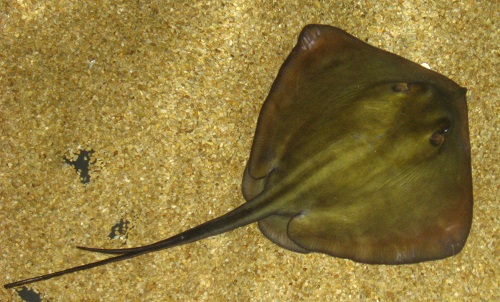
It is the most common ray in the waters of the Canary Islands. It can reach a wingspan of more than one meter, although most of the specimens found in Tenerife rarely exceed one and a half meters. They are very fast and agile, and can be found mainly in areas of large sandy surface and in dive sites where they are provided with food.
Black Mutt (Taeniura grabata)
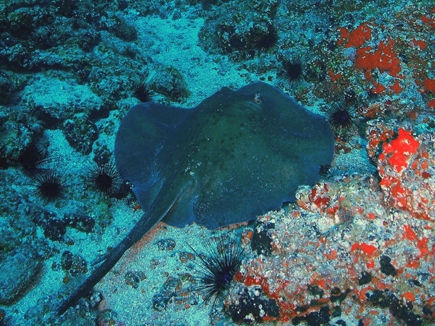
It prefers caves and dark projections. It can also cover itself with sand to go unnoticed. Encounters with this species are generally occasional but very enriching. If undisturbed, the black mutt remains in place without showing signs of nervousness. In case of being in the water, it will calmly move away from divers, but without being followed. It can reach a wingspan of up to 2.5 meters, and some scientists claim that this species may have come from the Red Sea.
Mantelina (Gymnura altavela)
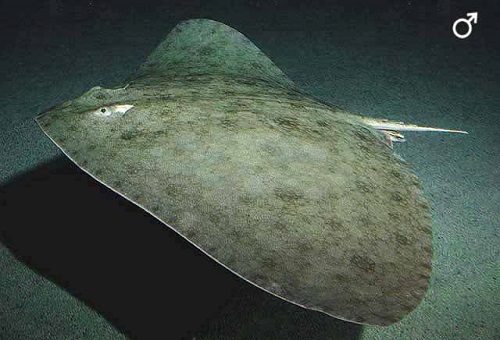
She swims with amazing grace, gliding over the seabed with almost surgical precision. She is an expert in camouflage, so it is very difficult to detect her when she is buried in the sand. Despite this, the Mantelina is convinced of its invisibility, which allows divers to get very close to it. If, unfortunately, the Mantelina feels vulnerable because it has been unearthed, it will flee at full speed, pushing bystanders in its path. This is not something that should be encouraged.
Torpedo ray (Torpedo marmorata)
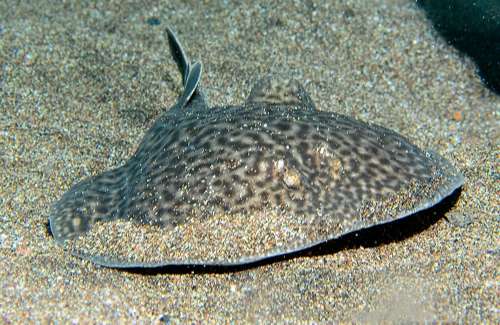
It is usually found hidden under the sand. It swims with difficulty, but has a defense system that can electrocute. It can produce electric shocks of up to 200 volts, which it also uses for hunting. If the ray is disturbed, it will rise up to show its belly, where the electricity-producing organs are located. The torpedo ray is aware of its relative invulnerability and, instead of fleeing, may even swim towards divers, who must stay out of its way. It can reach up to one meter in length, although the largest ray seen in Tenerife was no longer than 60 centimeters.
Mouse or silverside (Myliobatis aquila)
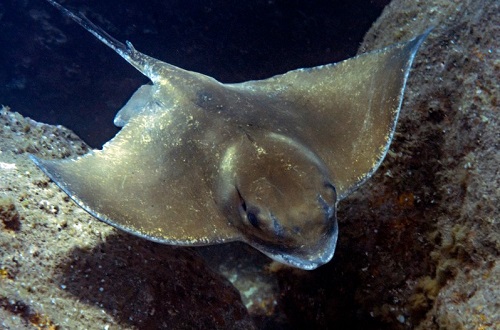
It is easily recognizable by its prominent forehead, which makes it look like a sea eagle. It uses its flippers as if it were a bird, which gives it a majestic movement. Although the mouse is curious and does not hesitate to approach to see what is going on, most encounters with them are at a safe distance or even out of visual range. The eagle ray can reach a wingspan of up to 1.5 meters.
Bishop ray (Pteromylaeus bovinus)
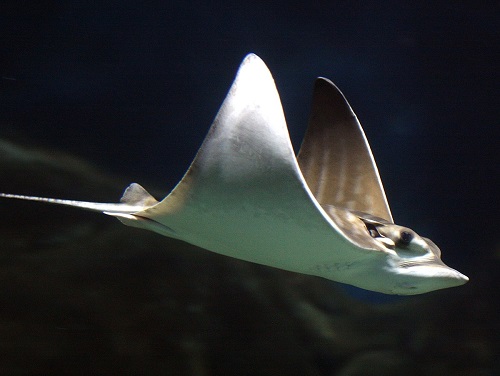
It can sometimes be seen on dives in Tenerife. Although encounters with this ray are rare, divers can enjoy every moment. It is similar in appearance to the mouse, but the clear bands on its back allow quick identification. It can reach over 2 meters in wingspan and its swimming style resembles the flight of an angel. It is difficult to approach and follow this species, but it can often be observed as it glides majestically along the seabed.
Nailed Mutt (Dasyatis centroura)
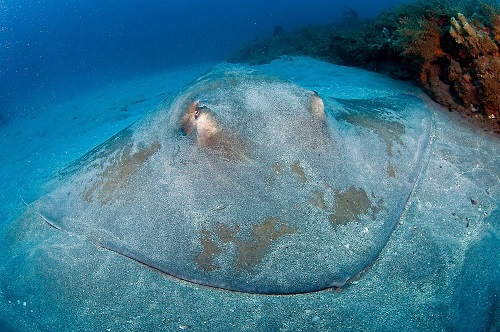
It is the largest stingray that can be found around Tenerife, with specimens up to 2 meters in the south of the island. This species is very sedentary and can be found mainly in feeding areas, under projections or in caves. It has a long, thick tail with small spikes at the base and impressive stingers. Divers should be careful when swimming near this stingray to avoid its sting, although they are generally peaceful animals that prefer to flee rather than attack.
What is the best time to see stingrays and manta rays in Tenerife?
The best time to see stingrays and manta rays in Tenerife is between the months of May and September, during the summer and early fall.
During this season, the Atlantic waters are warmer and visibility conditions are better, which facilitates the observation of these marine species.
However, it should be noted that the presence of rays and manta rays in the area is not guaranteed and may vary according to climatic and oceanographic conditions.
Curiosities about stingrays and manta rays
- Stingrays have cartilaginous skeletons, which means that instead of bones they have a cartilage structure that provides support and flexibility.
- Stingrays have an electrical detection system called the “ampulla of Lorenzini”, which allows them to detect electrical fields generated by other animals. They use this ability to locate prey and avoid predators.
- Manta rays have the ability to jump out of the water, reaching heights of up to two meters. This behavior is known as “breaching” and is believed to be used to get rid of parasites or to communicate with other members of their species.
- Manta rays have the largest brains of all fish and are known for their intelligence. They have demonstrated advanced cognitive abilities, such as the ability to recognize themselves in a mirror.
- Stingrays can be venomous and some species have venomous spines on their tails. These spines can cause severe pain and in some cases even death.
- Some species of stingrays are able to camouflage themselves in their environment by changing the color of their skin. This behavior helps them to hide from predators or to stalk their prey.
- Manta rays are known for their “gliding” swimming, in which they use their large fins to navigate through the water without flapping them as most fish do. They can swim at speeds of up to 24 km/h (15 mph).
- Stingrays have a very low reproductive rate and take a long time to mature sexually. For this reason, they are vulnerable to overfishing and are endangered in many areas of the world.
